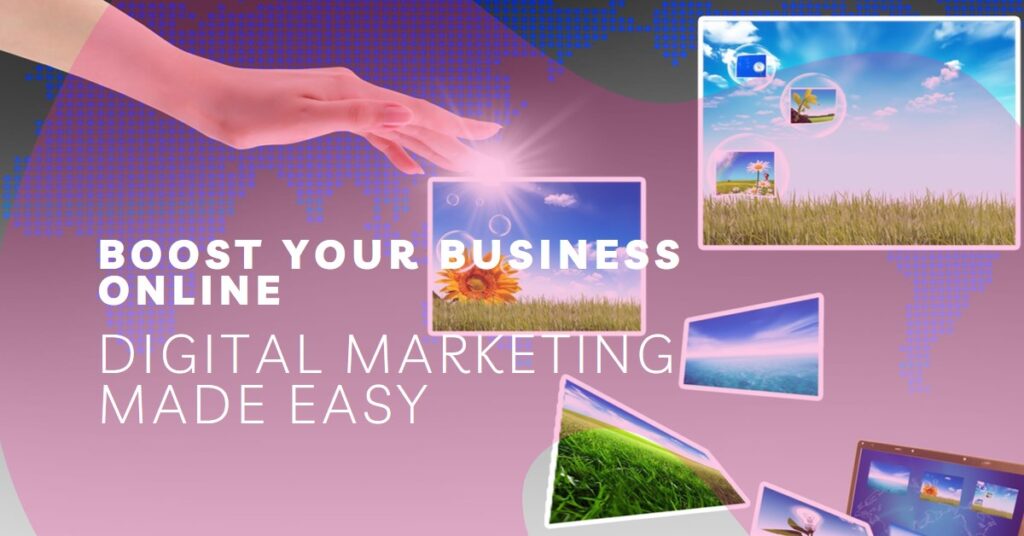A Broad Overview of Small Business Marketing
Know your small business customers first. Their needs, wants, and identities shape your marketing. Tailoring strategies to your audience’s interests is key. Understanding who you’re targeting lays the foundation for effective campaigns. Without this knowledge, marketing efforts may miss the mark.
Building a Strong Brand Character

Small businesses of all sizes need a compelling brand identity. It differentiates you from rivals and leaves a memorable mark. A strong brand helps you stand out and connect with customers.
Brand Name: Pick a memorable, relevant name that captures your small business’s essence. Short, catchy, and on-brand names stick best. Avoid obscure or confusing choices. Your name should instantly evoke what you do.
Logo Design: Craft a logo embodying your small business’s essence. Make it visually striking yet meaningful. Balance aesthetics with core values for the greatest impact. Your emblem should captivate and convey identity effortlessly.
Brand Messaging: Craft a concise yet compelling message. Make your unique value proposition shine through.
Brand Voice and Tone: Craft a distinct brand identity through your messaging. Let your small business’s personality shine in every word. Write with authenticity and consistency across all channels. Tailor your language to resonate with target audiences. Develop a signature style that sets you apart from competitors. Infuse your values and mission into your voice. Find the perfect equilibrium between professionalism and friendliness. Adapt your tone for different contexts while maintaining core brand elements. Refine your voice over time based on audience feedback and evolving goals. A compelling brand voice forges stronger connections and leaves a lasting impression.
Leveraging Digital Marketing

Small businesses can harness the power of digital marketing through targeted strategies. Social media engagement builds brand awareness and customer loyalty. SEO optimization boosts website visibility, driving organic traffic. Email campaigns nurture leads and maintain customer relationships. Pay-per-click advertising reaches potential customers who are searching for products or services. Content marketing establishes authority and attracts qualified leads. Analytics tools measure campaign effectiveness, allowing data-driven improvements. By leveraging these tactics, small businesses can compete effectively in the digital landscape.
Website Optimization:
Create an engaging site. It should have easy navigation and a clear, compelling button. It should drive visitors to take action. Focus on simplicity, beauty, and a smooth user experience. This will guide visitors to your goals.
Boost organic visibility through smart SEO tactics. Fine-tune your site to climb search rankings and attract more visitors.
Mobile-friendly websites are crucial in today’s digital landscape. With smartphone use skyrocketing, the site of your small business must adapt to smaller screens. Responsive design ensures content displays properly across devices, improving user experience. Quick loading times and easy navigation on phones keep visitors engaged. Don’t isolate possible buyers with an awkward mobile interface.
Digital Promotion of Your Small Business

Social Media Marketing:
Pinpoint your audience’s favored social networks. Where do they spend their digital hours? Track their online habits. Observe which sites capture their attention. Analyze engagement across platforms. Uncover the virtual spaces they frequent most. This insight guides your social strategy. Target efforts where your audience already gathers.
Share captivating posts, eye-catching images, and compelling videos across platforms. Write content that sparks interest and invites interaction. It should keep your audience coming back for more. Use diverse media types. It will appeal to various tastes and keep your small business’s online presence fresh.
Engage your audience swiftly. Reply to comments and messages without delay. Quick responses foster connection and loyalty. Timely interaction shows you value your followers’ input. Prompt engagement encourages further dialogue and builds community. Stay attuned to your audience’s voice. Make them feel heard and appreciated through swift, thoughtful replies.
Leverage social media’s paid ad platforms to expand your reach. These campaigns can amplify your small business’s message. They can connect you with potential customers beyond your current followers. Invest in promoted posts or sponsored content. It’ll boost visibility and engagement with diverse demographics. This approach boosts your online presence. It drives traffic and conversions better than organic posts alone.
Email Marketing:
Grow your subscriber base with enticing perks. Offer exclusive deals and content to lure readers into joining your mailing list. This strategy expands your small business’s reach while rewarding loyal followers.
Circulate routine newsletters filled with beneficial insights, promotions, and developments.
Change your email communications to heighten engagement.
Content Marketing:
Craft compelling content that captivates and educates. Engage readers with insightful blog posts, informative articles, and eye-catching infographics. These powerful tools will draw in your target audience and keep them coming back for more.
Boost online visibility by crafting search-friendly content.
Share your work across social networks and popular sites. Spread the word on Twitter, Facebook, Instagram, and LinkedIn. Post to Reddit, Medium, or niche forums in your field. Engage audiences where they gather online. Boost visibility through strategic, targeted promotion.
Pay-Per-Click (PPC) Advertising:
Use PPC ads to target specific keywords. This will expand your small business’s reach and attract new customers. This focused approach to online advertising can effectively broaden your audience.
Carefully track your PPC campaigns. This will optimize your budget and maximize your ROI.
Traditional Marketing Techniques
Online promotion is crucial, yet classic advertising remains valuable for local small businesses. Small firms enjoy both digital and time-tested approaches.
Print Marketing:
Craft vibrant event materials and business collateral. Design attention-grabbing brochures, flyers, and cards that captivate audiences and promote locations effectively.
Personalize your outreach with targeted direct mail campaigns, zeroing in on key demographics. Craft tailored messages that resonate with precision and impact.
Public Relations (PR):
Cultivate ties with nearby journalists. Engage regional news sources. Foster connections that yield publicity. Court hometown reporters for feature stories. Nurture press relationships to gain media exposure.
Generate buzz through strategic press events. Host conferences that showcase your small business, drawing media attention and public interest. Craft compelling narratives to captivate audiences and leave lasting impressions.
Networking:
Network at conferences and trade shows. Connect with potential customers and collaborators.
Get involved with local trade organizations to associate with other small business entrepreneurs.
Measuring Your Marketing Efforts

Track vital marketing metrics. Use analytics tools. Assess online visitor numbers, success rates, and client onboarding expenses. Track social media engagement, email open rates, and click-throughs. Analyze sales funnel performance and return on investment. Assess brand awareness and customer loyalty. Install A/B testing for continuous improvement. Regularly review data to refine strategies and boost effectiveness.
Website Traffic: Track website traffic and user interactions to gain valuable insights.
Social Media Engagement: Count likes, shares, responses, and follower ascent.
Email Open Rates and Click-Through Rates: Check the success rate of your email campaigns.
Conversion Rates: Track the percent of visitors who do a desired action, like buying something or signing up for a newsletter.
Return on Investment (ROI): Measure marketing ROI precisely. Determine costs versus gains for each campaign. Analyze data to optimize future spending. Track metrics diligently. Adjust strategies based on performance. Maximize budget efficiency through careful assessment.
Adapting to the Changing Landscape
Agile small businesses thrive in marketing’s shifting terrain. Embrace emerging trends and tools to stay ahead. Experiment boldly with fresh strategies. Adapt swiftly as markets change. Your competitive edge depends on constant evolution and a willingness to innovate.
FAQs
How can a small business with a limited budget install successful marketing strategies?
Stretch your marketing dollars with savvy tactics. Create compelling content, engage on social platforms, and craft targeted emails. Leverage no-cost resources to expand your audience. Smart, budget-friendly approaches can yield impressive results without breaking the bank.
What is the best way to measure the success of my small business’s marketing campaigns?
Website traffic, social media engagement, and email open rates reveal campaign impact. Track these key performance indicators (KPIs) to gauge effectiveness. Conversion rates and ROI offer deeper insights into campaign success. Measure these metrics to optimize your marketing efforts and drive results.
How often should I post on social media for my small business?
Tune your posting rhythm to your audience and platform. Strike a balance: be consistent without flooding feeds. Test and adjust to uncover your ideal schedule. With strategic timing, your content will resonate and engage.
How can I build a strong online reputation for my small business?
Build relationships with industry influencers and engage your audience actively. Encourage satisfied customers to share positive feedback online. Address negative reviews quickly and courteously. Cultivate a strong presence on social media and your website through meaningful interactions.
Conclusion
Small businesses can use digital and traditional marketing. They can connect with customers, boost brand recognition, and increase revenue. Success hinges on a creative, consistent strategy that puts the customer first. By blending old and new techniques, even small firms can thrive in today’s market. It’s very competitive.

